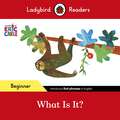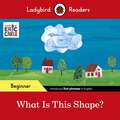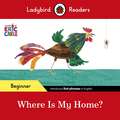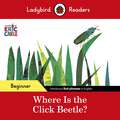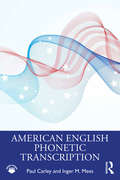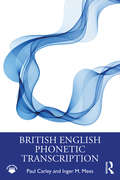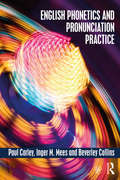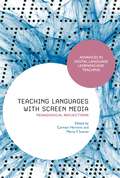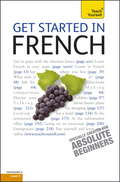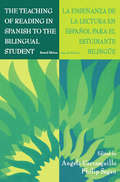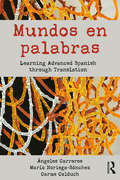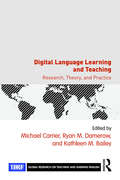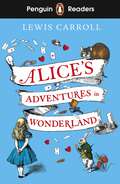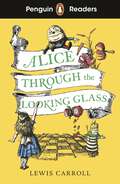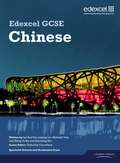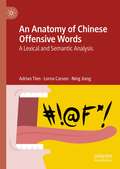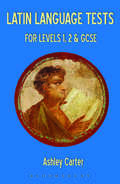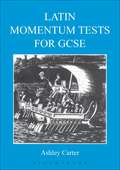- Table View
- List View
Ladybird Readers Beginner Level - Eric Carle - What Is It? (Ladybird Readers)
by Eric Carle LadybirdLadybird Readers is an ELT graded reader series for children aged 3-11 learning English as a foreign or second language. The series includes traditional tales, favourite characters, modern stories and non-fiction. Written by experts, it uses proven methods to help children learn English and grasp key grammar and vocabulary points.Perfect for learning English in school or at homeDevelops reading, writing, speaking, listening and critical thinking skillsFeatures much-loved characters and authors such as Peter Rabbit, Peppa Pig, Roald Dahl and Eric CarleEight levels follow the Common European Framework of Reference for language learning (CEFR)Language activities in every book provide preparation for the Cambridge English Pre-A1 to A2 (YLE) testsFeatures free online resources including audio, answer keys, lesson plans and tips for parentsWhat Is It? a Beginner level Reader, helps children to learn and practice their first words in English. It introduces everyday phrases and focuses on vocabulary that young children can use in daily life. Simple text and repetition support understanding, and speaking and listening activities develop confidence.Is it a jaguar? Is it a monkey?Visit the Ladybird Education website for more information
Ladybird Readers Beginner Level - Eric Carle - What Is This Shape? (Ladybird Readers)
by Eric Carle LadybirdLadybird Readers is an ELT graded reader series for children aged 3-11 learning English as a foreign or second language. The series includes traditional tales, favourite characters, modern stories and non-fiction. Written by experts, it uses proven methods to help children learn English and grasp key grammar and vocabulary points.Perfect for learning English in school or at homeDevelops reading, writing, speaking, listening and critical thinking skillsFeatures much-loved characters and authors such as Peter Rabbit, Peppa Pig, Roald Dahl and Eric CarleEight levels follow the Common European Framework of Reference for language learning (CEFR)Language activities in every book provide preparation for the Cambridge English Pre-A1 to A2 (YLE) testsFeatures free online resources including audio, answer keys, lesson plans and tips for parentsWhat Is This Shape? a Beginner level Reader, helps children to learn and practice their first words in English. It introduces everyday phrases and focuses on vocabulary that young children can use in daily life. Simple text and repetition support understanding, and speaking and listening activities develop confidence.What shape is the cloud?Visit the Ladybird Education website for more information.
Ladybird Readers Beginner Level - Eric Carle - Where Is My Home? (Ladybird Readers)
by Eric Carle LadybirdLadybird Readers is an ELT graded reader series for children aged 3-11 learning English as a foreign or second language. The series includes traditional tales, favourite characters, modern stories and non-fiction. Written by experts, it uses proven methods to help children learn English and grasp key grammar and vocabulary points.Perfect for learning English in school or at homeDevelops reading, writing, speaking, listening and critical thinking skillsFeatures much-loved characters and authors such as Peter Rabbit, Peppa Pig, Roald Dahl and Eric CarleEight levels follow the Common European Framework of Reference for language learning (CEFR)Language activities in every book provide preparation for the Cambridge English Pre-A1 to A2 (YLE) testsFeatures free online resources including audio, answer keys, lesson plans and tips for parentsWhere Is My Home?, a Beginner level Reader, helps children to learn and practice their first words in English. It introduces everyday phrases and focuses on vocabulary that young children can use in daily life. Simple text and repetition support understanding, and speaking and listening activities develop confidence."Where is my home?" says the rooster.Visit the Ladybird Education website for more information.
Ladybird Readers Beginner Level - Eric Carle - Where Is the Click Beetle? (Ladybird Readers)
by Eric Carle LadybirdLadybird Readers is an ELT graded reader series for children aged 3-11 learning English as a foreign or second language. The series includes traditional tales, favourite characters, modern stories and non-fiction. Written by experts, it uses proven methods to help children learn English and grasp key grammar and vocabulary points.Perfect for learning English in school or at homeDevelops reading, writing, speaking, listening and critical thinking skillsFeatures much-loved characters and authors such as Peter Rabbit, Peppa Pig, Roald Dahl and Eric CarleEight levels follow the Common European Framework of Reference for language learning (CEFR)Language activities in every book provide preparation for the Cambridge English Pre-A1 to A2 (YLE) testsFeatures free online resources including audio, answer keys, lesson plans and tips for parentsWhere is the Click Beetle?, a Beginner level Reader, helps children to learn and practice their first words in English. It introduces everyday phrases and focuses on vocabulary that young children can use in daily life. Simple text and repetition support understanding, and speaking and listening activities develop confidence.It is morning! The click beetle walks.Visit the Ladybird Education website for more information.
American English Phonetic Transcription
by Paul Carley Inger M. MeesAmerican English Phonetic Transcription provides an accessible introduction to phonemic, phonetic, and intonational transcription with a focus on American English. Featuring exercises, revision tasks, and recordings to help students gain hands-on practice, the book takes a learning-by-doing approach and ensures students gain practice using each new symbol or concept introduced before moving on to the next. Consisting of three parts, the book covers: transcribing individual words, including consonants, vowels, primary stress, secondary stress, syllabic consonants, and inflections; transcribing phrases and sentences, including weak forms, elision, and assimilation; transcribing intonation, including the structure of English intonation and recognizing pitch patterns. Ideally suited as a standalone workbook or for use alongside British English Phonetic Transcription, American English Phonetic Transcription is key reading for undergraduate students of linguistics as well as anyone teaching or learning English as a foreign language.
American English Phonetic Transcription
by Paul Carley Inger M. MeesAmerican English Phonetic Transcription provides an accessible introduction to phonemic, phonetic, and intonational transcription with a focus on American English. Featuring exercises, revision tasks, and recordings to help students gain hands-on practice, the book takes a learning-by-doing approach and ensures students gain practice using each new symbol or concept introduced before moving on to the next. Consisting of three parts, the book covers: transcribing individual words, including consonants, vowels, primary stress, secondary stress, syllabic consonants, and inflections; transcribing phrases and sentences, including weak forms, elision, and assimilation; transcribing intonation, including the structure of English intonation and recognizing pitch patterns. Ideally suited as a standalone workbook or for use alongside British English Phonetic Transcription, American English Phonetic Transcription is key reading for undergraduate students of linguistics as well as anyone teaching or learning English as a foreign language.
British English Phonetic Transcription
by Paul Carley Inger M. MeesBritish English Phonetic Transcription provides an accessible introduction to phonemic, phonetic and intonational transcription with a focus on British English. Featuring exercises, revision tasks and recordings to help students gain hands-on practice, the book takes a learning-by-doing approach and ensures students gain practice using each new symbol or concept introduced before moving on to the next. Consisting of three parts, the book covers: transcribing individual words, including consonants, vowels, primary stress, secondary stress, syllabic consonants and inflections; transcribing phrases and sentences, including liaison, weak forms, elision and assimilation; transcribing intonation, including the structure of English intonation and recognising pitch patterns. Ideally suited as a standalone workbook or for use alongside American English Phonetic Transcription, British English Phonetic Transcription is key reading for undergraduate students of linguistics as well as anyone teaching or learning English as a foreign language.
British English Phonetic Transcription
by Paul Carley Inger M. MeesBritish English Phonetic Transcription provides an accessible introduction to phonemic, phonetic and intonational transcription with a focus on British English. Featuring exercises, revision tasks and recordings to help students gain hands-on practice, the book takes a learning-by-doing approach and ensures students gain practice using each new symbol or concept introduced before moving on to the next. Consisting of three parts, the book covers: transcribing individual words, including consonants, vowels, primary stress, secondary stress, syllabic consonants and inflections; transcribing phrases and sentences, including liaison, weak forms, elision and assimilation; transcribing intonation, including the structure of English intonation and recognising pitch patterns. Ideally suited as a standalone workbook or for use alongside American English Phonetic Transcription, British English Phonetic Transcription is key reading for undergraduate students of linguistics as well as anyone teaching or learning English as a foreign language.
English Phonetics and Pronunciation Practice
by Paul Carley Inger M. Mees Beverley CollinsEnglish Phonetics and Pronunciation Practice provides a unique introduction to basic articulatory phonetics for students of English. Built around an extensive collection of practice materials, this book teaches the pronunciation of modern standard non-regional British English to intermediate and advanced learners worldwide. This book: provides an up-to-date description of the pronunciation of modern British English; demonstrates the use of each English phoneme with a selection of high-frequency words, both alone and in context in sentences, idiomatic phrases and dialogues; provides examples and practice material on commonly confused sounds, including illustrative pronunciation diagrams; is supported by a companion website featuring phonetic transcriptions and over 30 hours of practice audio material to check your pronunciation against; can be used not only for studying pronunciation in the classroom but also for independent student practice. English Phonetics and Pronunciation Practice is essential reading for any student studying this topic.
English Phonetics and Pronunciation Practice
by Paul Carley Inger M. Mees Beverley CollinsEnglish Phonetics and Pronunciation Practice provides a unique introduction to basic articulatory phonetics for students of English. Built around an extensive collection of practice materials, this book teaches the pronunciation of modern standard non-regional British English to intermediate and advanced learners worldwide. This book: provides an up-to-date description of the pronunciation of modern British English; demonstrates the use of each English phoneme with a selection of high-frequency words, both alone and in context in sentences, idiomatic phrases and dialogues; provides examples and practice material on commonly confused sounds, including illustrative pronunciation diagrams; is supported by a companion website featuring phonetic transcriptions and over 30 hours of practice audio material to check your pronunciation against; can be used not only for studying pronunciation in the classroom but also for independent student practice. English Phonetics and Pronunciation Practice is essential reading for any student studying this topic.
Teaching Languages with Screen Media: Pedagogical Reflections (Advances in Digital Language Learning and Teaching)
by Carmen Herrero and Marta F. SuarezIn recent years, the expansion of screen media, including film, TV, music videos, and computer games, has inspired new tools for both educators and learners. This book illustrates how screen media can be exploited to support foreign language (L2) teaching and learning.Drawing on a range of theories and approaches from second language acquisition, audio-visual translation, multimodality, and new media and film studies, this book provides both best practices and in-depth research on this interdisciplinary field. Areas of screen media-enhanced learning and teaching are covered across 4 sections: film and broadcast media, in-depth case studies, translation and screen media, and interactive media. With a focus on pedagogical approaches to teaching and learning Spanish, French, German, and English as a Foreign Language, Teaching Languages with Screen Media presents innovative insights in this new interdisciplinary field.
Get Started in Beginner's French: Teach Yourself Enhanced Amazon (Ty: Language Guides)
by Catrine CarpenterAre you looking for a course in French written for the absolute beginner who has no experience of learning a foreign language? Get Started in French will give you the confidence to communicate in French. Now fully updated to make your language learning experience fun and interactive. You can still rely on the benefits of a top language teacher and our years of teaching experience, but now with added learning features within the course and online. The emphasis of the course is placed on communication, rather than grammar, and all the teaching is in English, so that you will quickly and effortlessly get started in French. By the end of this course, you will be at Level B1 of the Common European Framework for Languages: Can deal with most situations likely to arise whilst travelling in an area where the language is spoken. Learn effortlessly with new, full-colour easy-to-read page design and interactive features: NOT GOT MUCH TIME?One, five and ten-minute introductions to key principles to get you started.AUTHOR INSIGHTSLots of instant help with common problems and quick tips for success, based on the author's many years of experience.USEFUL VOCABULARYEasy to find and learn, to build a solid foundation for speaking.DIALOGUESRead and listen to everyday dialogues to help you speak and understand fast.PRONUNCIATIONDon't sound like a tourist! Perfect your pronunciation before you go.TEST YOURSELFTests in the book and online to keep track of your progress.EXTEND YOUR KNOWLEDGEExtra online articles at: www.teachyourself.com to give you a richer understanding of the culture and history of France.TRY THISInnovative exercises illustrate what you've learnt and how to use it.The course is available as a book (9781444100709), as a pack comprising the book and double CD (9781444100716) and as a double CD (9781444100723).
The Teaching of Reading in Spanish to the Bilingual Student: La Ense¤anza De La Lectura En Espa¤ol Para El Estudiante Biling e
by Angela Carrasquillo Philip SeganThis dual-language text provides theory and methodology for teaching reading in Spanish to Spanish/English bilingual or Spanish-dominant students. The goal is to help educators teach these students the skills necessary to become proficient readers and, thus, successful in the school system. At the very core of the book are the hispano-parlantes--the Spanish-speaking children--who bring to the schools, along with their native language and cultures, a wealth of resources that must be tapped and to whom all educators have a responsibility to respond. True to the concepts of developing bilingual educators to serve bilingual students, the text presents chapters in English and Spanish. Each chapter is written in only one language at the preference of the author. Thus, to be successful with this book, the reader must be bilingual. Themes emphasized in the text include current reading methodologies, the concept of reading as developmental literacy skills, reading in the content areas, new views of the development of proficiency in the second language, issues related to students with special learning needs, assessment, and the uses of technology in the delivery of instruction. Never losing sight of its goal--to teach reading in Spanish to bilingual or Spanish-dominant students--the book includes a series of focusing questions and follow-up activities; these are not simply translations of existing activities, strategies, and techniques intended for monolingual English students, but specifically designed to be appropriate for Spanish-speaking students. Directed to university preservice and in-service instructors of reading and bilingual education as well as administrators and district- and school-level staff developers who work with Hispanic populations, the book is sensitive at all times to nuances of the languages and cultures of the intended audiences.
The Teaching of Reading in Spanish to the Bilingual Student: La Ense¤anza De La Lectura En Espa¤ol Para El Estudiante Biling e
by Angela Carrasquillo Philip SeganThis dual-language text provides theory and methodology for teaching reading in Spanish to Spanish/English bilingual or Spanish-dominant students. The goal is to help educators teach these students the skills necessary to become proficient readers and, thus, successful in the school system. At the very core of the book are the hispano-parlantes--the Spanish-speaking children--who bring to the schools, along with their native language and cultures, a wealth of resources that must be tapped and to whom all educators have a responsibility to respond. True to the concepts of developing bilingual educators to serve bilingual students, the text presents chapters in English and Spanish. Each chapter is written in only one language at the preference of the author. Thus, to be successful with this book, the reader must be bilingual. Themes emphasized in the text include current reading methodologies, the concept of reading as developmental literacy skills, reading in the content areas, new views of the development of proficiency in the second language, issues related to students with special learning needs, assessment, and the uses of technology in the delivery of instruction. Never losing sight of its goal--to teach reading in Spanish to bilingual or Spanish-dominant students--the book includes a series of focusing questions and follow-up activities; these are not simply translations of existing activities, strategies, and techniques intended for monolingual English students, but specifically designed to be appropriate for Spanish-speaking students. Directed to university preservice and in-service instructors of reading and bilingual education as well as administrators and district- and school-level staff developers who work with Hispanic populations, the book is sensitive at all times to nuances of the languages and cultures of the intended audiences.
Mundos en palabras: Learning Advanced Spanish through Translation
by Ángeles Carreres María Noriega-Sánchez Carme CalduchMundos en palabras offers advanced students of Spanish a challenging yet practical course in translation from English into Spanish. The course provides students with a well-structured, step-by-step guide to Spanish translation which will enhance and refine their language skills while introducing them to some of the key concepts and debates in translation theory and practice. Each chapter presents a rich variety of practical tasks, supported by concise, focused discussion of key points relating to a particular translation issue or text type. Shorter targeted activities are combined with lengthier translation practice. Throughout the book, learners will find a wealth of material from a range of genres and text types, including literary, expository, persuasive and audiovisual texts. An answer key to activities, as well as supplementary material and Teachers’ Notes are provided in the companion website. The book covers common areas of difficulty including: frequent grammatical errors calques and loan words denotation and connotation idioms linguistic varieties cultural references style and register Suitable both for classroom use and self-study, Mundos en palabras is ideal for advanced undergraduate students of Spanish, and for any advanced learners wishing to acquire translation competence while enhancing their linguistic skills.
Mundos en palabras: Learning Advanced Spanish through Translation
by Ángeles Carreres María Noriega-Sánchez Carme CalduchMundos en palabras offers advanced students of Spanish a challenging yet practical course in translation from English into Spanish. The course provides students with a well-structured, step-by-step guide to Spanish translation which will enhance and refine their language skills while introducing them to some of the key concepts and debates in translation theory and practice. Each chapter presents a rich variety of practical tasks, supported by concise, focused discussion of key points relating to a particular translation issue or text type. Shorter targeted activities are combined with lengthier translation practice. Throughout the book, learners will find a wealth of material from a range of genres and text types, including literary, expository, persuasive and audiovisual texts. An answer key to activities, as well as supplementary material and Teachers’ Notes are provided in the companion website. The book covers common areas of difficulty including: frequent grammatical errors calques and loan words denotation and connotation idioms linguistic varieties cultural references style and register Suitable both for classroom use and self-study, Mundos en palabras is ideal for advanced undergraduate students of Spanish, and for any advanced learners wishing to acquire translation competence while enhancing their linguistic skills.
Digital Language Learning and Teaching: Research, Theory, and Practice (Global Research on Teaching and Learning English)
by Michael Carrier Ryan M. Damerow Kathleen M. BaileyThis carefully balanced set of studies and practitioner research projects carried out in various learning contexts around the world highlights cutting-edge research in the use of digital learning technologies in language classrooms and in online learning. Providing an overview of recent developments in the application of educational technology to language learning and teaching, it looks at the experience of researchers and practitioners in both formal and informal (self-study) learning contexts, bringing readers up to date with this rapidly changing field and the latest developments in research, theory, and practice at both classroom and education system levels.
Digital Language Learning and Teaching: Research, Theory, and Practice (Global Research on Teaching and Learning English)
by Michael Carrier Ryan M. Damerow Kathleen M. BaileyThis carefully balanced set of studies and practitioner research projects carried out in various learning contexts around the world highlights cutting-edge research in the use of digital learning technologies in language classrooms and in online learning. Providing an overview of recent developments in the application of educational technology to language learning and teaching, it looks at the experience of researchers and practitioners in both formal and informal (self-study) learning contexts, bringing readers up to date with this rapidly changing field and the latest developments in research, theory, and practice at both classroom and education system levels.
Penguin Readers Level 2: Alice's Adventures in Wonderland (Penguin Readers (graded Readers) Ser.penguin Readers Series)
by Lewis CarrollPenguin Readers is an ELT graded reader series. Please note that the eBook edition does NOT include access to the audio edition and digital book. Written for learners of English as a foreign language, each title includes carefully adapted text, new illustrations and language learning exercises.Titles include popular classics, exciting contemporary fiction, and thought-provoking non-fiction, introducing language learners to bestselling authors and compelling content.The eight levels of Penguin Readers follow the Common European Framework of Reference for language learning (CEFR). Exercises at the back of each Reader help language learners to practise grammar, vocabulary, and key exam skills. Before, during and after-reading questions test readers' story comprehension and develop vocabulary.Alice in Wonderland, a Level 2 Reader, is A1+ in the CEFR framework. Sentences contain a maximum of two clauses, introducing the future tenses will and going to, present continuous for future meaning, and comparatives and superlatives. It is well supported by illustrations, which appear on most pages.Alice goes after a white rabbit into Wonderland. There she meets the Mad Hatter, the Duchess and many other famous people and animals in Lewis Carroll's famous story.Visit the Penguin Readers websiteRegister to access online resources including tests, worksheets and answer keys. Exclusively with the print edition, readers can unlock a digital book and audio edition (not available with the eBook).
Penguin Readers Level 3: Alice Through the Looking Glass
by Lewis CarrollPenguin Readers is an ELT graded reader series for learners of English as a foreign language. With carefully adapted text, new illustrations and language learning exercises, the print edition also includes instructions to access supporting material online.Titles include popular classics, exciting contemporary fiction, and thought-provoking non-fiction, introducing language learners to bestselling authors and compelling content.The eight levels of Penguin Readers follow the Common European Framework of Reference for language learning (CEFR). Exercises at the back of each Reader help language learners to practise grammar, vocabulary, and key exam skills. Before, during and after-reading questions test readers' story comprehension and develop vocabulary.Alice Through the Looking Glass, a Level 3 Reader, is A2 in the CEFR framework. The text is made up of sentences with up to three clauses, introducing first conditional, past continuous and present perfect simple for general experience. It is well supported by illustrations, which appear on most pages.Alice is playing with her kitten when she begins to feel tired. Suddenly the looking-glass moves and changes color. Alice steps through the glass into a magic world. It is even stranger than Wonderland... what might she find there?Visit the Penguin Readers websiteExclusively with the print edition, readers can unlock online resources including a digital book, audio edition, lesson plans and answer keys.
Edexcel Gcse Chinese (PDF)
by K. CarruthersThe Edexcel GCSE Chinese Student Book is designed to appeal to teenagers and give your students a true picture of life in China while covering all aspects of the new specification.
An Anatomy of Chinese Offensive Words: A Lexical and Semantic Analysis
by Lorna Carson Ning Jiang Adrian TienThis book offers a precise and rigorous analysis of the meanings of offensive words in Chinese. Adopting a semantic and cultural approach, the authors demonstrate how offensive words can and should be systematically researched, documented and accounted for as a valid aspect of any language. The book will be of interest to academics, practitioners and students of sociolinguistics, language and culture, linguistic taboo, Chinese studies and Chinese linguistics.
Latin Language Tests for Levels 1 and 2 and GCSE
by Ashley CarterThis collection of tests provides practice for students preparing to take the new Latin language examinations at the WJEC examination board Levels 1 and 2. It also includes tests similar to those used in the OCR examination board GCSE examinations. The book is divided into five sections, each devoted to a different format or level of tests. Words that are not expected to be known at each level are glossed. The range of grammatical and syntactical features is similar to that found in the public examinations. The tests are designed to cover translation and comprehension of specially constructed stories in Latin. Readers are not expected to have familiarity with any particular course book, and the stories may also be used simply as a graduated Latin reader, if desired.Also available from Bloomsbury: Latin Language Tests, by Mark Schemes 9781853997525
Latin Language Tests for Levels 1 and 2 and GCSE
by Ashley CarterThis collection of tests provides practice for students preparing to take the new Latin language examinations at the WJEC examination board Levels 1 and 2. It also includes tests similar to those used in the OCR examination board GCSE examinations. The book is divided into five sections, each devoted to a different format or level of tests. Words that are not expected to be known at each level are glossed. The range of grammatical and syntactical features is similar to that found in the public examinations. The tests are designed to cover translation and comprehension of specially constructed stories in Latin. Readers are not expected to have familiarity with any particular course book, and the stories may also be used simply as a graduated Latin reader, if desired.Also available from Bloomsbury: Latin Language Tests, by Mark Schemes 9781853997525
Latin Momentum Tests for GCSE
by Ashley CarterThis collection of 15 tests is modelled on those used in GCSE examinations. The first few are at the standard of Foundation Tier and provide appropriate practice for Foundation Tier candidates as well as an easier introduction to the harder tests for Higher Tier candidates. The remaining tests are designed for Higher Tier candidates. All the tests contain a range of grammatical and syntactical features appropriate for GCSE and assume a basic knowledge of about 500 words of vocabulary; other words and proper names are glossed. Each test consists of three sections: a passage of about 60 words, tested by simple comprehension questions; a passage of about 100 words, for translation; and a passage of about 90 words, tested by more demanding questions. A gradient of difficulty is maintained throughout the Latin. Each test also has two mark schemes, suitable for use by the teacher or by the student for self-assessment.
